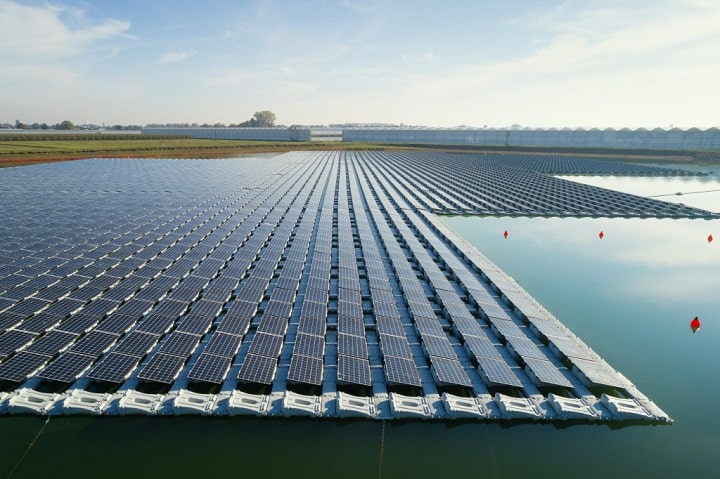- Describe the concept of a floating solar power plant and how different is it from the land-based source of renewable energy?
Floating solar or FSPV is the concept of solar on water, where-in buoyant structures called floats are used to mount the PV panels. They can be installed on a number of waterbodies like dams, lakes, irrigation canals, water treatment ponds, quarry, and mining lakes, etc.
In recent times, floating solar plants are grasping a lot of attention as they are influencing the environmental, economic, and social section better than other renewable energy segments.
Environmental benefits: Minimizes water evaporation (water & ecosystems conservation), Improves water quality, and reduces algal bloom, Make PV possible when there is a lack of space.
Economic benefits: Converts unused spaces into profitable areas, enhances electricity generation (thanks to the cooling effect), Reduces grid-connection costs and major infrastructures investments.
Social benefits: Preserves valuable lands for other uses, Rehabilitates contaminated areas with clean energy, Compatible with recreational activities, Environmental convenience, positive aesthetics.
- Why do we need the concept of floating solar power plants when the traditional renewable power plants have been enjoying acceptance already?
The Indian subcontinent, being the 2nd most populated, is facing a growing energy need, with scarcity of land, legal issues in land acquisitions, disputes, infinite acquisition delays, etc. With all this, ground/roof mount solar/renewable plants are becoming a challenge. India will be one of the biggest markets for floating solar in the coming years. The government has also set an ambition of adding 10 GW of floating solar by the year 2022.
Land based solar plants (or any renewable energy plants for that instance,) require huge land space. By opting for a floating solar plant, the land can be used for something more beneficial in the line. Land based plants also demand removal of trees, disturbing the natural ecosystem.
- Describe the inroads made by floating solar power plants in the Indian renewable energy landscape.
Floating solar has a lot of scope in India with its diverse landscape and available water bodies, that can be turned into revenue and energy yielding resources.
It is gaining a lot of traction recently and the government has also set a target of achieving 10 GW floating solar power capacity by 2022.
CIAL (Cochin International Airport Limited), Kochi – India’s first fully solar powered airport hosts a 452 kWp floating solar plant.
NTPC (National Thermal Power Corporation) is in the process of setting up 270+ MW of floating solar plants.
The WBPDCL (West Bengal Power Development Corporation Limited) installed a 5.4 MWp floating solar plant in the raw water pond in Sagardighi Thermal Power Plant, making it the first floating solar plant to be set up in a thermal power plant. Following that they have now floated tenders for another 15 MW floating solar projects.
Leading player in the petrochemical industry, Southern Petrochemical Industries Corporation has also installed a 25 MW floating solar plant in Tamil Nādu.
Apart from these, there are more than 1 GW of floating solar projects in the pipeline, which are in different development stages.
- Where does the training of the personnel stand for the installation of photovoltaic panels on the water bodies?
Unlike conventional solar, floating solar itself is a new concept and requires lot of R&D to be done to make any project successful. Each project is unique, and they cannot be replicated. A proper, detailed survey of the project location is needed to obtain the bathymetry, SPT, wave and current resistance, and wind speed.
The industry is now well trained to install a ground mount/roof top solar, and they are well equipped to meet challenges. But installing a floating solar plant is no cake walk as there are more engineering challenges that we may come across. Only trained and experienced personnel can carry out the installation.
Developers are starting to grasp the technology and training is done as per the general guidelines and Best-known methods drafted for floating solar by pioneers in the industry.
- Discuss the long term and short-term advantages of floating solar power plants in terms of their efficiency vis-a-vis land-based solar power plants.
Due to the water proximity, there is an increased yield in energy, when compared to conventional solar plants.
The Solar Energy Research Institute of Singapore’s observed a PV panels temperature 3 to 10 degrees lower on floating PV plants compared to rooftop systems in Singapore with a yield increase of 5 to 10%.
The Solar Energy Application Centre (SEAC) recorded a decrease up to 6 degrees in PV panels temperature in the Netherlands with a yield increase estimated at 2 to 3%.
- How expensive is it to set up a floating solar power plant?
The delta difference between floating solar and conventional solar plants is less than 10%. It may again vary depending on the project site and complexities it comes with. But taking energy generation into picture, floating solar produces better energy due to the lower temperature around them. Lower the temperature around the panels, higher the energy generation. The capacity increase of FPV plants can intensely decrease the levelized cost of energy (LCOE).
- How big a waterbody would one require to set up a basic floating solar power plant!
A 1 MWp floating PV plant has a footprint of approximately 1 ha on the water body. Distance between the floating arrays and the banks is required which means that the maximum coverage ratio of the water body is 65% in average. It is suggested that only 50% of the area is covered when it is a natural waterbody or if it contains natural habitats, hence limiting the effect of the floating solar plant on the aquatic culture.
- What are the challenges that come along with floating solar power plants, and how can they be neutralized?
The primary challenge is that the floating solar projects must be sustainable for 25 years.
Unlike ground mount, floating solar must Keep the fundamental techniques intact. Each site should have unique designs depending on the topography of the area. The variation in the water level and the undercurrent of the water also poses challenges, especially when it comes to anchoring and moving the floating platforms.
Site visit before design and site surveys to undergo the Bathymetry, SPT, Wind speed, Wave analysis, should be considered while making a design suit.
Quality is paramount to protect the asset for 25 years at least. It is important to consider wind resistance, Wave and current resistance, mechanical resistance, floatability, UV resistance, Drinking water compliance, Temperature resistance.







































